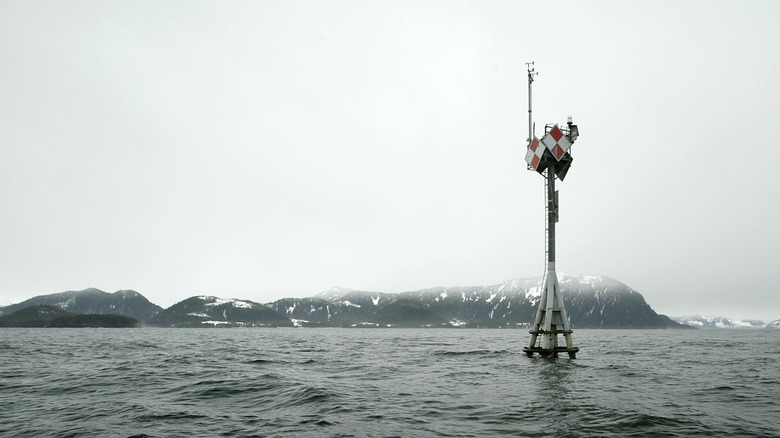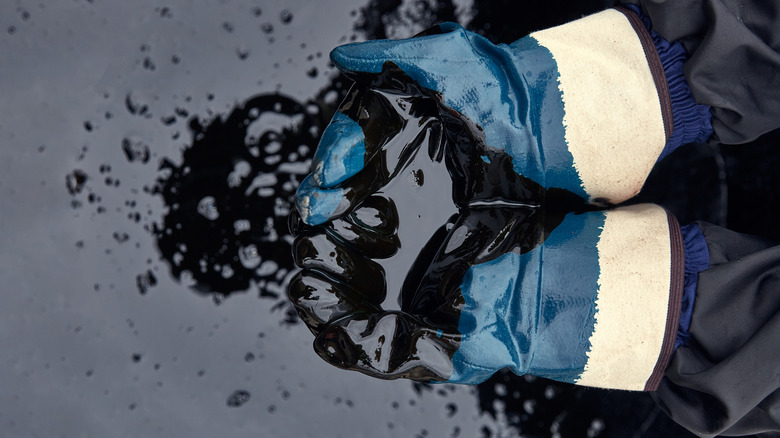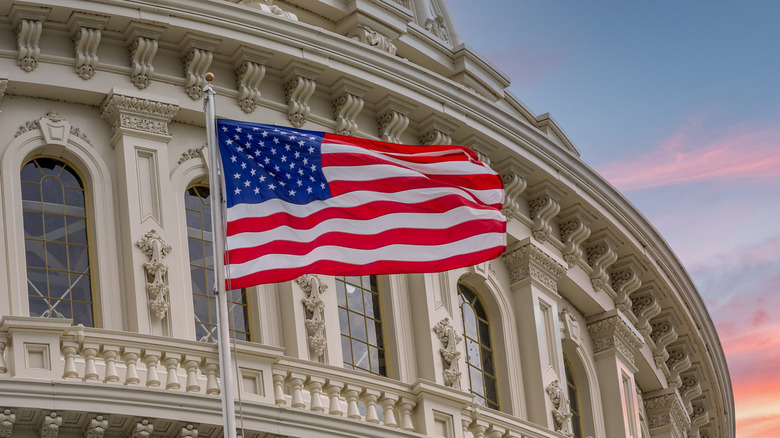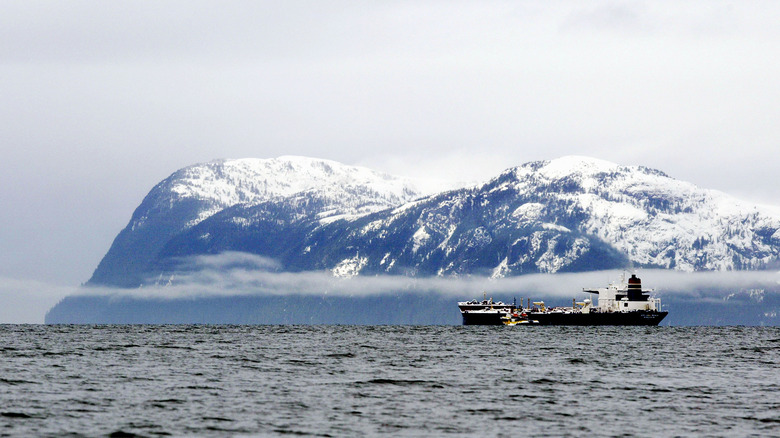Chilling Details About The Exxon Valdez Oil Spill
Four minutes after midnight on the morning of March 24, 1989, an oil tanker off the coast of Alaska ran aground, and the ocean bled.
The Exxon Valdez oil spill was an environmental disaster that would bring enormous change to the oil industry as a whole, and would be the impetus for the passing of the Oil Pollution Act by the U.S. Congress and the Bush Administration in 1990. The crash resulted in an estimated 11 million gallons of crude oil spilling into the Prince William Sound on Alaska's southern gulf, and for 21 years, it was widely regarded as the worst oil spill in U.S. history (via History).
The spill would impact over a thousand miles of shoreline and lead to immense devastation for the fish and wildlife of the region, as well as have massive ramifications for the industries and communities along the coast (via NOAA). Even today, more than three decades later, it is not unheard of to stumble across leftover pockets of crude oil in the sound (reports History).
You may have heard the saying that "safety standards are written in blood," but how did this spill happen? Was it bad luck? Negligence? A combination of both? How much impact did it really have?
Crude Oil and Cheap Booze
Let's go back to the beginning. On the evening of March 23, 1989, the Exxon Valdez departed from Valdez, Alaska, and was bound for Long Beach, California when it struck Bligh Reef. It was impacting this reef that caused the rupture in the hull of the tanker, which in turn caused the spill (via History). Bligh Reef is a reef off the coast of Bligh Island in Prince William Sound, and was widely known to be a hazard when navigating the Sound.
If the reef was so well known as a navigational hazard, how did the Exxon Valdez not manage to avoid it? Accidents happen, of course, but oil spills are far more serious than some spilled milk.
Well, after an investigation into the cause of the crash, evidence was discovered that suggested the ship's captain, Joseph Hazelwood, had not only been drinking in the time leading up to the crash, but had allowed a member of his crew without an official license to steer the tanker (via History). Hazelwood escaped felony charges, but was ultimately convicted of misdemeanor negligence. He was fired, fined, and ordered to perform 1,000 hours of community service. The larger blame for the incident, meanwhile, would fall primarily into the lap of Exxon itself, for a number of reasons.
A $5-billion mistake
Amid all the panic, unfortunately, no immediate effort was made to contain the oil after the initial crash. Between the delayed action and the strong winds and rough currents of the area, the oil spread quickly outward, until 1,300 miles of shoreline — that's over 23,000 football fields — and the surrounding waters had been polluted (via Britannica).
The National Transportation Safety Board (NTSB) would pin most of the blame for the spill on Exxon. The crew of the Exxon Valdez, the NTSB suggested, was unskilled and ill-equipped, not to mention overburdened with work (via Britannica).
Exxon settled in 1991, two years after the spill, paying over $1 billion in criminal plea agreement and restitution and civil settlement for the case (via NOAA). In addition, the company would go on to pay over $2 billion providing funding to clean-up efforts for the spill, as well as another $2 billion funding environmental restoration areas for the region and paying personal damages to the residents and businesses along the affected coastline (via History).
It was a valiant effort to mend the impacts of a very costly mistake. Unfortunately, billions of dollars spent on damages could not erase the environmental impact the spill had, and continues to have, on the once-immaculate Alaskan wilderness.
The Real Cost of the Spill
What does 11 million gallons of crude oil even look like? 11 million gallon jugs of milk floating in the ocean would certainly be noticeable, but even that's a bit difficult to imagine. Let's put it this way; if your average bathtub holds about 40 gallons of liquid in it (via USGS), then you would need 275,000 bathtubs to contain the 11 million gallons of oil spilled into Prince William Sound. This amount of oil would have a massive impact on any environment, but Prince William Sound was an ecologically sensitive (via NOAA) and pristine wilderness (via History), prior to the spill.
The crash devastated local fisheries and wildlife, destroying billions of salmon and herring eggs as well as killing an estimated 250,000 seabirds, 2,800 sea otters, hundreds of harbor seals and bald eagles, and even a number of orcas (via NOAA). As of 2020, the National Oceanic and Atmospheric Administration (NOAA) reported that three species of seabird and a family of orcas impacted by the Exxon Valdez spill were still not recovering, over 30 years later.
Work is still being conducted to monitor the effects of the oil on the environment, as well as to rehabilitate and protect the harbors and wildlife along the affected coastline.
The Oil Pollution Act of 1990
In direct response to the disaster, the Oil Pollution Act was passed by the U.S. Congress and signed into law by George H. W. Bush in 1990. The goal of this legislation was ultimately to create procedures that would lessen the impact of potential future spills. Procedures for responding to spill incidents were established, alongside delineated legal liabilities for any parties responsible for said incidents (via History).
In addition, the Oil Pollution Act aimed to see single-hulled oil tankers banned from U.S. waters by 2015. The Exxon Valdez was a single-hull tanker, but a tanker with a double-hull design perhaps would not have ruptured upon impact with Bligh Reef, preventing the untold and lasting damage caused by the spill (via History). The European Union (EU) would eventually follow suit, banning single-tanker models from EU waters. As such, the Exxon Valdez, alongside many other tankers like it, was relegated to serving primarily in Asian waters (via Britannica).
Oil Tanker, Ore Carrier, and Absolute Disaster
After the Exxon Valdez was recovered from the crash site, the tanker was repaired and returned to service on the Mediterranean Sea under a different name; the Exxon Mediterranean. The ship would sail several different waters and go through a half dozen names, before eventually being sold to a Hong Kong shipping company in 2008, whereupon it would be converted to an ore carrier and renamed to the Dong Feng Ocean (via History and Britannica).
And in 2010, the Dong Feng Ocean proceeded to collide with another ship while traveling across the Yellow Sea — once again severely damaging the vessel (via History). Oops.
The story of the Exxon Valdez ended somewhat anticlimactically in 2012. The infamous ship was sold for scrap metal to a company in Alang, India under its final name, the Oriental Nicety, and was ultimately dismantled (via Britannica). Good night, sweet arbiter of ecological disaster.





